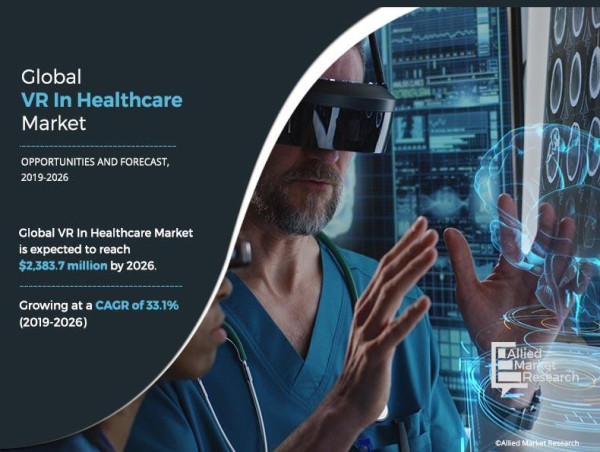PORTLAND, OREGON, UNITED STATES, August 1, 2023/EINPresswire.com/ -- The healthcare industry has witnessed a remarkable revolution with the integration of Virtual Reality (VR) technology. In 2018, the VR in healthcare market size surged to a promising $240.91 million. However, the true potential of this transformative technology is yet to be fully realized. Projections indicate a phenomenal growth trajectory, with an estimated value of $2,383.68 million by the year 2026. This exceptional expansion is expected to be fueled by an impressive Compound Annual Growth Rate (CAGR) of 33.18% from 2019 to 2026.
Virtual Reality has not only become an integral part of healthcare, but it has also become a driving force behind cutting-edge medical innovations. The immersive and interactive nature of VR enables healthcare professionals to engage in unprecedented ways with patients, diagnose complex conditions more accurately, and provide personalized treatments.
𝐃𝐨𝐰𝐧𝐥𝐨𝐚𝐝 𝐒𝐚𝐦𝐩𝐥𝐞 𝐑𝐞𝐩𝐨𝐫𝐭: https://www.alliedmarketresearch.com/request-sample/6558
Key Market Players
1. 𝐎𝐫𝐜𝐚 𝐇𝐞𝐚𝐥𝐭𝐡
2. 𝐌𝐢𝐜𝐫𝐨𝐬𝐨𝐟𝐭 𝐂𝐨𝐫𝐩𝐨𝐫𝐚𝐭𝐢𝐨𝐧
3. 𝐃𝐀𝐐𝐑𝐈
4. 𝐀𝐥𝐩𝐡𝐚𝐛𝐞𝐭 𝐈𝐧𝐜. (𝐆𝐨𝐨𝐠𝐥𝐞)
5. 𝐒𝐲𝐧𝐜𝐓𝐡𝐢𝐧𝐤 𝐈𝐧𝐜.
6. 𝐆𝐞𝐧𝐞𝐫𝐚𝐥 𝐄𝐥𝐞𝐜𝐭𝐫𝐢𝐜
7. 𝐄𝐜𝐡𝐨𝐏𝐢𝐱𝐞𝐥
8. 𝐅𝐢𝐫𝐬𝐭𝐡𝐚𝐧𝐝 𝐓𝐞𝐜𝐡𝐧𝐨𝐥𝐨𝐠𝐲 𝐈𝐧𝐜.
9. 𝐊𝐨𝐧𝐢𝐧𝐤𝐥𝐢𝐣𝐤𝐞 𝐏𝐡𝐢𝐥𝐢𝐩𝐬 𝐍.𝐕. (𝐏𝐡𝐢𝐥𝐢𝐩𝐬)
10. 𝐀𝐩𝐩𝐥𝐢𝐞𝐝𝐕𝐑
𝐕𝐑 𝐢𝐧 𝐇𝐞𝐚𝐥𝐭𝐡𝐜𝐚𝐫𝐞 𝐌𝐚𝐫𝐤𝐞𝐭 𝐑𝐞𝐩𝐨𝐫𝐭 𝐇𝐢𝐠𝐡𝐥𝐢𝐠𝐡𝐭𝐬:
1. Technology Segmentation: The VR in healthcare market report highlights the various technologies that are driving the adoption of virtual reality in the healthcare sector. These technologies include:
• Head-Mounted Technology: Head-mounted displays (HMDs) are one of the most popular VR technologies in healthcare. They provide an immersive experience by projecting virtual content directly in front of the user's eyes, making them suitable for medical training, patient education, and therapy applications.
• Gesture-Tracking Technology: Gesture-tracking technology enables users to interact with the virtual environment using hand and body movements. This intuitive interaction method finds applications in rehabilitation exercises and virtual therapy sessions, enhancing patient engagement and outcomes.
• Projector & Display Walls Technology: This technology involves projecting virtual content onto large display walls or screens, creating shared and collaborative VR experiences. It is particularly useful in research laboratories and medical education settings.
2. Product Segmentation: The market report also categorizes VR products based on their nature and application within the healthcare industry. These product categories include:
• VR Semiconductor Components: These are the underlying building blocks of VR devices, such as processors and graphic cards, responsible for rendering realistic virtual environments and ensuring smooth user experiences.
• VR Devices: This category encompasses the various VR hardware devices used in healthcare, including headsets, motion controllers, and haptic feedback devices. VR devices play a crucial role in delivering immersive and interactive experiences to users.
• VR Sensors: VR sensors are essential for tracking the user's movements and interactions, enabling real-time updates of the virtual environment based on the user's actions. They are particularly relevant for applications like physical therapy and rehabilitation.
• Others: This category includes any additional VR-related products or components that might be relevant to the healthcare industry but do not fit into the previous classifications.
3. End User Segmentation: The report identifies the key end users of VR technology in the healthcare sector:
• Hospitals and Clinics: VR technology is finding extensive applications in hospitals and clinics for medical training, pain management, and preoperative planning, among other uses. Its adoption in these settings is expected to improve patient outcomes and optimize medical procedures.
• Research Laboratories: Research laboratories are exploring the potential of VR in various healthcare studies, such as cognitive research, human-computer interaction, and medical simulations. VR's ability to create controlled and customizable environments makes it a valuable tool for research purposes.
• Other End Users: This category includes any other healthcare-related entities that utilize VR technology for their specific needs, such as nursing homes, medical universities, and home healthcare providers.
𝐅𝐑𝐄𝐐𝐔𝐄𝐍𝐓𝐋𝐘 𝐀𝐒𝐊𝐄𝐃 𝐐𝐔𝐄𝐒𝐓𝐈𝐎𝐍𝐒?
1. How has the adoption of VR technology in the healthcare market evolved over the past five years?
2. What are the most promising applications of VR in the healthcare industry beyond medical training and patient education?
3. How does the VR in healthcare market differ regionally, and what factors contribute to these variations?
4. What are the primary challenges faced by healthcare providers in implementing VR technology, and how are they being addressed?
5. Are there any specific ethical or privacy concerns associated with the use of VR in patient care, and how are they being mitigated?
6. What role does artificial intelligence (AI) play in enhancing VR experiences and medical outcomes in the healthcare market?
7. Are there any notable collaborations between VR technology developers and healthcare institutions to drive innovation in the industry?
8. How is the integration of VR technology in medical simulations impacting the overall quality of medical education and training?
9. What are the potential cost-saving benefits of using VR in the healthcare market, and how do they compare to traditional methods?
10. What are the latest advancements in VR haptic feedback technology, and how are they being leveraged to improve patient rehabilitation and therapy outcomes?
𝐏𝐮𝐫𝐜𝐡𝐚𝐬𝐞 𝐏𝐫𝐞𝐦𝐢𝐮𝐦 𝐂𝐨𝐩𝐲 𝐨𝐟 𝐕𝐑 𝐢𝐧 𝐇𝐞𝐚𝐥𝐭𝐡𝐜𝐚𝐫𝐞 𝐌𝐚𝐫𝐤𝐞𝐭 𝐆𝐫𝐨𝐰𝐭𝐡 𝐑𝐞𝐩𝐨𝐫𝐭 𝐚𝐭: https://www.alliedmarketresearch.com/vr-in-healthcare-market/purchase-options
𝐁𝐫𝐨𝐰𝐬𝐞 𝐌𝐨𝐫𝐞 𝐑𝐞𝐩𝐨𝐫𝐭𝐬:
VR in Healthcare Market - https://www.alliedmarketresearch.com/vr-in-healthcare-market-A06193
Remote Patient Monitoring Market - https://www.alliedmarketresearch.com/remote-patient-monitoring-market
David Correa
Allied Analytics LLP
1 800-792-5285
email us here



